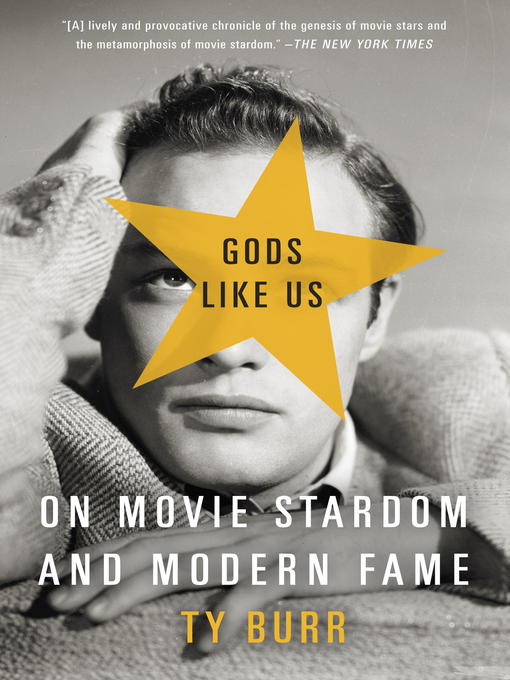
Gods Like Us
On Movie Stardom and Modern Fame
کتاب های مرتبط
- اطلاعات
- نقد و بررسی
- دیدگاه کاربران
نقد و بررسی

July 9, 2012
In this fascinating cultural study, film critic Burr explores the rise of stars in the early film industry. Burr argues “that every successful star creates a persona and within that persona is an idea the films are merely variations on the idea.” Early stars were Mary Pickford, Charlie Chaplin, Bette Davis, and Clark Gable, but Brando broke the mold, and now, Burr argues, “his DNA... courses through our young actors and movie stars.” Burr chronicles the star system—silents, talkies, movie factories, postwar studios—while citing factors such as television (“evoked not glamour, but ordinariness”), music (Elvis Presley, Michael Jackson, Madonna), MTV, HBO, and YouTube (“teenagers have at their disposal the fundamental moviemaking facilities of a Hollywood studio in the 1930s”). In this solid analysis of celebrity, he offers insight on the career arcs of Meryl Streep, Tom Cruise (“not an actor but a huge global superstar”), Harrison Ford, Kevin Costner, and Jodie Foster. Agent: Sarah Burnes, The Gernert Company.

July 15, 2012
The film critic of the Boston Globe explores film celebrity and waxes philosophical about what it means to and for the rest of us. Burr (The Best Old Movies for Families, 2007, etc.) has both a fan's and scholar's grasp of the history of film, and he travels along a celluloid highway that extends from the early days of Thomas Edison to Zac Efron. Of greatest interest to the author is our evolving notion of celebrity--of what celebrities mean. He cites few authorities to support his view of our psychology, however, and he freely employs locutions like we want and we expect throughout. Burr notes that the earliest performers were anonymous, until actress Florence Lawrence (1886-1938). After that, the author ably shows, the names became virtually all. At near fast-forward speed, he takes us through the careers and contributions of the pioneer generation (Lillian Gish, Charlie Chaplin, Tom Mix et al.), with some stops for closer looks at the rise and precipitous fall of Fatty Arbuckle, the arrival of the talkies and the emergence of the great screen presences of the 1930s and '40s--Gable, Harlow, Cagney, Bogart and others. Burr examines how studios sought to homogenize and manage their performers' images (we knew what we were getting in a John Wayne film), and he offers a lengthy analysis of, and tribute to, Brando. He then deviates a bit from his subtitle by looking at the varying natures of celebrity in TV and popular music. He also mentions the meltdowns of Cruise and Gibson and the difficulties for female actors (they must not age). A focused history of films that occasionally flirts with--but does not wed--portentousness.
COPYRIGHT(2012) Kirkus Reviews, ALL RIGHTS RESERVED.

August 1, 2012
More than a century of detail is incorporated into this fine history of stardom from the early days of silent film through the contemporary world of YouTube. Burr (film critic, Boston Globe; The Best Old Movies for Families: A Guide to Watching Together) traces the rise of Hollywood legends, television stars, and musicians ranging from Mary Pickford, Lucille Ball, and Marlon Brando to Tom Cruise and Michael Jackson. He analyzes their roles both onscreen and off, their symbolic significance, and how they have inspired both the adoration and the envy of their audiences. Burr offers incisive commentary on the changing face of stardom as a reflection of and an influence on society-at-large, its defining parameters expanding over time beyond the film world with the advent of increasingly sophisticated technological advances in television, video, and the Internet. Although more recent innovations like YouTube have made it easier to become famous, they have diminished some of stardom's former glamour. VERDICT This is a well-written and well-researched work about the multiple complexities of stardom that will appeal to a wide general readership.--Carol J. Binkowski, Bloomfield, NJ
Copyright 2012 Library Journal, LLC Used with permission.

August 1, 2012
Burr, a prominent film critic for the Boston Globe since 2002, tackles our enduring fascination with celebrities in this comprehensive examination of stardom throughout the past century. Burr's insights are focused primarily on movie stars (as opposed to television, sports, or music stars) and the question we all want the answer to: What are they really like? This exhaustive, and occasionally exhausting, book connects the dots between the original constellation of classic Hollywood icons (Mary Pickford, Charlie Chaplin, Rudolph Valentino) through the so-called golden age (Clark Gable, Bette Davis, John Wayne) and the biggest stars of the modern era (Johnny Depp, Will Smith, Julia Roberts). With more than 25 years of film watching and analysis under his belt, Burr clearly knows this subject matter well and has a valuable point of view. Certain claims, however, such as A film without a star remains a nearly impossible sell, ring somewhat untrue in the age of The Hunger Games and Twilight, two blockbuster film franchises that have created a new batch of young stars for us to obsess over.(Reprinted with permission of Booklist, copyright 2012, American Library Association.)

























دیدگاه کاربران